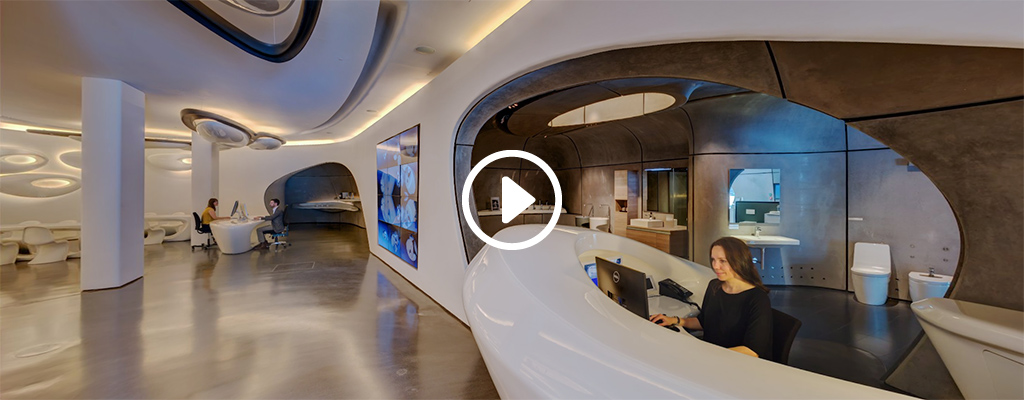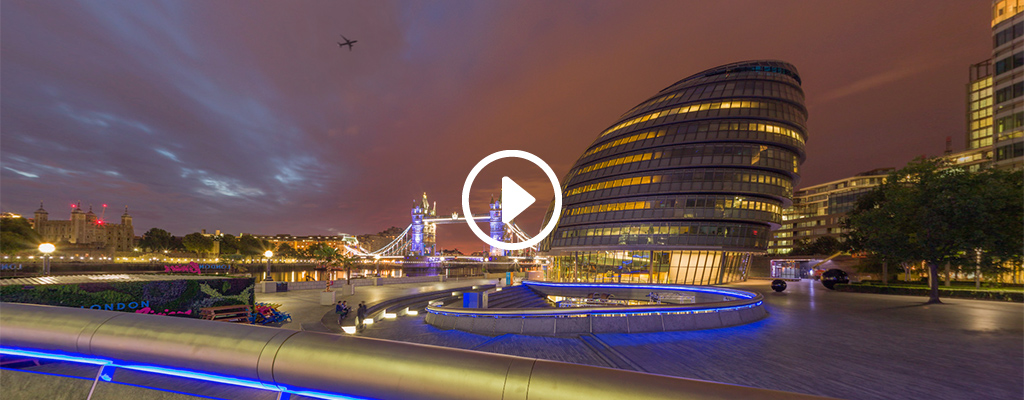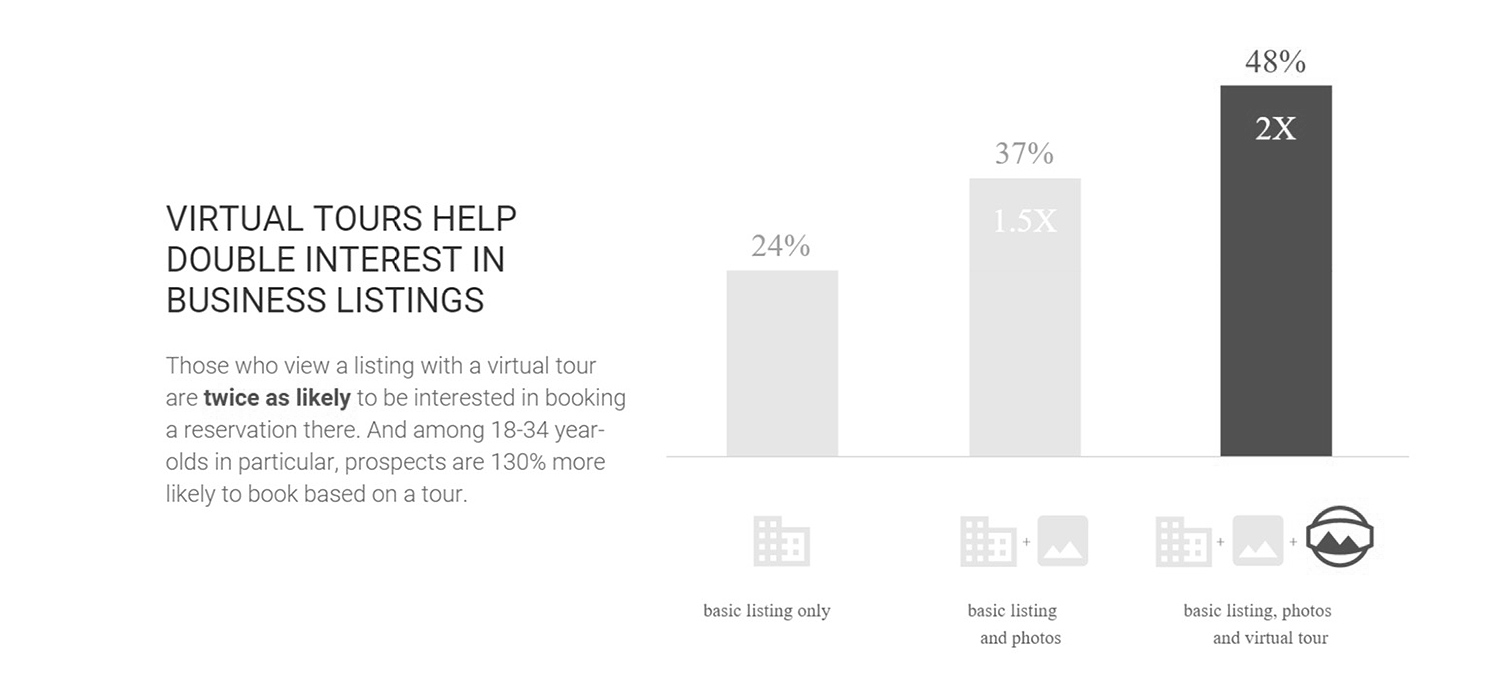360 virtual tour technology is a powerful promotional tool, with numerous advantages over more traditional forms of media content. The marketing implications of this high-impact technology are huge, and the latest industry statistics support this.
360 virtual tours are invaluable to many types of business. However, it’s their unique ability to showcase the entire three dimensional space, that makes them particularly valuable to the architecture, interior design, property and real estate industries.
360 virtual tours can combine many forms of content in one convenient, multimedia presentation. This can include stills photographs, videos, drawings, Google maps, floor plans, real location sounds and even guided voiceover or 360 video tours.
360 virtual tours can be viewed on computers, mobile phones and tablets. In addition to this, they can also be viewed on affordable virtual reality (VR) headsets, or by using a cheap Google Cardboard and smartphone. This means a finished project or property can be virtually experienced at any time, by clients and potential buyers from anywhere in the world. VR technology is also the perfect promotional tool for trade shows and events – increasing sales and raising brand identity.

360 virtual tours can be produced in many different ways, from using a simple iPhone app, to hiring somebody with an automated 360 camera system. However, to achieve the very best quality and aesthetics, my team and I shoot with a high resolution DSLR, a fisheye lens and fully manual techniques. We prefer to take this more skilled approach, to create breathtaking images and the highest quality 360 virtual tours. This method of working produces industry leading 24k (265 megapixel) tours, that far exceed the low quality 8k (30 megapixel) tours generated by automated camera systems.
360 virtual tours made with DSLR can also be remapped to produce high resolution photographic stills images. This 24k interactive panorama of the Millennium Bridge was output to an incredible 110 megapixel stills photograph. This level of resolution is perfect for all traditional print purposes, large format wall displays, billboards and even building wraps.
Architecture & Interior Design
Interactive 360 virtual tours are invaluable to the architecture and interior design industries for a number of reasons:
- Traditional stills and video are limited to a two dimensional space, but 360 degree photographic imagery captures the entire three dimensional space. A 360 virtual tour is able to immerse the viewer within that space, and place the finished project within the context of its environment.
- A carefully produced 360 virtual tour is more practical, more functional and just as aesthetically pleasing as conventional imagery. There really is no better way to convey the sense of place, impart the feeling of light and capture all the elements of design, than with a high quality interactive 360 virtual tour.
- 360 virtual tours allow architectural and interior design studios to conveniently showcase their portfolio of past and present projects to potential clients. Once a project has been completed, it is often difficult to gain access to these occupied locations. However, by using interactive 360 virtual tours and VR technology, clients can experience entire projects remotely, from anywhere in the world.
- 3D visualisations using CGI technology are primarily helpful at the concept stage, since they do not represent reality. High quality 360 photography captures the reality of a finished project, and bring the original 3D visualisations to life.
Real Estate
Interactive 360 virtual tours are now recognised as one of the most effective ways to market and promote real estate. A 360 virtual tour will help to sell a commercial or residential property far quicker than stills or video.
The National Association of Realtors in the USA, has a vested interest in determining if 360 virtual tours are helping or hurting their member’s businesses. Their annual reports are always great sources of research into the subject. Here are some of their recent findings:
- A listing with a virtual tour gets around 87% more views than those without 360 virtual tours.
- Over 50% of buyers will not even look at a property unless it has a 360 virtual tour.
- The majority of internet users found 360 virtual tours to be a significant factor in influencing their purchasing decision.
- 360 virtual tours reduce the number of wasted viewing hours by 40%, saving the vendor time and money.
“Virtual tours keep people looking at a website 5 to 10 times longer”
A recent ‘trend study’ in Planet Home also concluded that 75% of potential customers and visitors consider a virtual tour to be a major decision making aid before proceeding to a purchase. A high quality 360 virtual tour will literally help a property to sell itself.
Business
Nearly all types of business can benefit from 360 virtual tour technology. Whilst photos and videos are effective, they’re becoming standard and losing their impact.
When a business has an interactive 360 virtual tour created, it offers something unique, immersive and cutting edge. For this reason alone, interactive 360 media has a far higher impact and is considered far more ‘sticky’ than more traditional forms of image content.
Here are some statistics from an independent survey commissioned by Google:
The longer a visitor spends on a web page, the higher it will rank in search results. When there’s a virtual tour to maintain interest, visitors are much more likely to resist leaving a website. This can boost Google SEO results considerably, and is therefore becoming an increasingly important element of commercial marketing strategies.
Adding 360 virtual tours to a website is still a relatively new concept, which means that many businesses don’t have one yet. By adding a 360 virtual tour to a website before the competition, a business will stand out and be ahead of the curve – increasing brand identity and ultimately profit.
“360 virtual tours help double interest in business”
More and more companies are adopting 360 media as their benefits are becoming increasingly apparent. This trend is expected to continue as marketers recognise the unparallelled and unique potential of 360 virtual tours.
Since early 2020, the global Coronavirus pandemic has accelerated this growth exponentially, as we are now all leading more virtual lives and unnecessary travel has been restricted.
Click here to read the blog post and case study on Dezeen’s Goldsmith Street multimedia 360 virtual tour.
Click here to view the interactive 360 virtual tour page.




